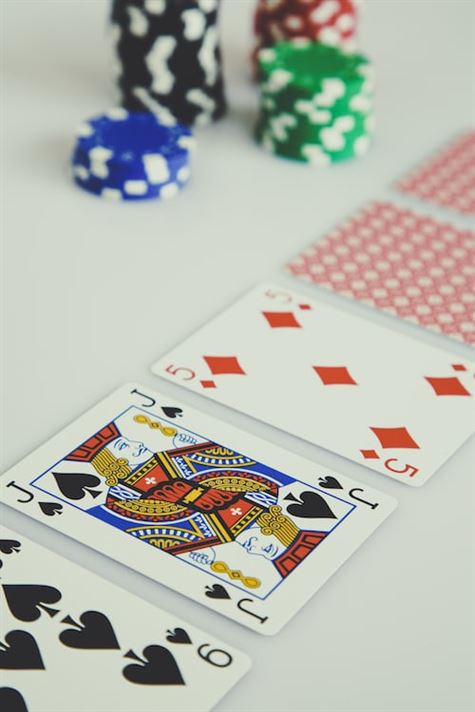Poker Odds Unveiled: Calculating Success in Every Hand is a comprehensive guide that explores the world of poker odds and equips players with the necessary skills to make informed decisions at the table. This book delves into the mathematical aspects of the game, providing readers with a solid foundation for understanding the probability of various outcomes in different poker scenarios. By mastering the art of calculating odds, players can significantly improve their chances of success and gain an edge over their opponents. Whether you are a beginner or an experienced player looking to enhance your skills, Poker Odds Unveiled is an invaluable resource that will take your poker game to the next level.
Understanding Poker Probability: A Beginner’s Guide to Calculating Odds
Poker is a game of skill and strategy, but it also involves an element of chance. Understanding the odds and probabilities in poker is crucial to making informed decisions and increasing your chances of success. In this beginner’s guide, we will delve into the world of poker probability and uncover how to calculate the odds in every hand.
To begin with, let’s clarify what we mean by odds and probabilities in poker. Odds refer to the ratio of winning to losing outcomes, while probabilities represent the likelihood of a specific outcome occurring. These concepts are essential for determining whether a particular move or decision is mathematically sound or not.
One of the fundamental aspects of calculating poker odds is understanding the concept of outs. Outs are cards that can improve your hand and potentially lead to a winning combination. For example, if you have four cards to a flush, there are nine remaining cards of that suit in the deck. Therefore, you have nine outs to complete your flush.
Once you have determined your number of outs, you can use this information to calculate your odds of hitting your desired card on the next street. The rule of 2 and 4 is a simple method used to estimate these odds. If you are on the flop and want to know the odds of completing your hand by the river, multiply your number of outs by two to get an approximate percentage. If you are on the turn, multiply by four instead.
However, it is important to note that these estimates are not precise, but rather rough approximations. To obtain more accurate odds, one must consider factors such as the number of players at the table, their playing style, and previous betting patterns. These variables can significantly influence the likelihood of certain outcomes.
Furthermore, understanding pot odds is another crucial aspect of calculating poker probabilities. Pot odds compare the potential payout of a bet to the cost of calling that bet. By comparing these two values, you can determine whether a bet is profitable in the long run. If the pot odds are greater than the odds of completing your hand, it may be a wise decision to call.
For example, if the pot contains $100 and your opponent bets $20, you would need to contribute $20 to potentially win $120. If your odds of completing your hand are 1 in 4 (25%), then the pot odds are favorable, as they exceed the odds of hitting your desired card. In this scenario, calling would be a mathematically sound decision.
Moreover, understanding implied odds can further enhance your poker strategy. Implied odds consider potential future bets and winnings that may occur if you hit your desired card. These additional factors can significantly impact the profitability of a particular move.
In conclusion, calculating poker odds is an essential skill for any serious player. By understanding concepts such as outs, pot odds, and implied odds, you can make more informed decisions and increase your chances of success. Remember, however, that poker is not just about mathematics; it also involves psychology, reading opponents, and making strategic moves. But by mastering the art of calculating probabilities, you will undoubtedly have a significant advantage at the poker table.
Mastering the Art of Hand Analysis: How to Calculate Poker Probabilities
Poker is a game of skill and strategy, but it also involves a fair amount of luck. One of the key skills that separates successful poker players from the rest is the ability to calculate probabilities and odds. By understanding the likelihood of certain outcomes, players can make more informed decisions about whether to bet, raise, or fold.
To begin calculating poker probabilities, it’s important to understand the basic principles of probability theory. Probability is a measure of how likely an event is to occur, expressed as a number between 0 and 1. A probability of 0 means that an event will never happen, while a probability of 1 means that an event is certain to happen.
In poker, probabilities are often calculated based on the number of outs – cards that could improve a player’s hand. For example, if a player has four hearts in their hand and there are two hearts on the flop, they have nine outs to make a flush (13 hearts in total minus the four they already have). To calculate the probability of making a flush on the next card, the player would divide the number of outs by the number of unknown cards (52 minus the player’s hand and the community cards).
Another important concept in poker probability is pot odds. Pot odds compare the current size of the pot to the cost of a contemplated call. If the pot odds are higher than the odds of completing a drawing hand, it may be profitable to make the call. For example, if the pot is $100 and it costs $20 to call, the pot odds are 5 to 1. If the player’s odds of completing their hand are better than 5 to 1, it would be a mathematically sound decision to make the call.
Calculating poker probabilities becomes more complex when multiple factors are involved. For example, a player may have an open-ended straight draw with two overcards – cards that are higher than any on the board. In this situation, the player has more outs to improve their hand, but calculating the exact probability requires considering all possible outcomes.
Fortunately, there are tools available to help players calculate poker probabilities quickly and accurately. Online poker calculators can take into account a player’s hand, the community cards, and other relevant factors to provide an estimate of the probability of winning the hand. These calculators can be invaluable for making quick decisions in fast-paced games or when faced with complex situations.
However, it’s important to note that poker probabilities are not guarantees. Just because a certain outcome is likely doesn’t mean it will always happen. Poker is a game of incomplete information, and unexpected events can occur at any time. It’s crucial for players to understand the limitations of probability calculations and to use them as tools to inform their decision-making rather than relying on them blindly.
In conclusion, mastering the art of hand analysis in poker requires a solid understanding of probability theory and the ability to calculate odds. By considering factors such as outs, pot odds, and multiple variables, players can make more informed decisions about whether to bet, raise, or fold. While online calculators can assist in these calculations, it’s important to remember that poker probabilities are not guarantees and should be used as tools to guide decision-making rather than as absolute truths. With practice and experience, players can develop their skills in calculating probabilities and increase their chances of success in every hand.
Essential Tools for Calculating Poker Odds: Software and Strategies
Poker is a game of skill and strategy, where players must make calculated decisions based on the odds of winning each hand. To be successful in poker, it is crucial to have a good understanding of poker odds and how to calculate them accurately. In this article, we will delve into the essential tools for calculating poker odds: software and strategies.
One of the most effective tools for calculating poker odds is specialized software. These programs are designed to analyze various factors and provide players with accurate probabilities. Poker odds calculators, for example, can instantly calculate the likelihood of winning a hand based on the cards dealt and the community cards on the table. This allows players to make informed decisions about whether to fold, call, or raise.
There are several types of poker odds calculators available, ranging from basic ones that only calculate hand strength to advanced ones that consider multiple variables such as opponent tendencies and pot odds. Some calculators even offer real-time advice during gameplay, helping players make optimal decisions in real-time.
While poker software can be incredibly helpful, it is important not to rely solely on it. Developing a solid understanding of the underlying concepts and strategies is equally important. Calculating poker odds manually allows players to develop their intuition and make more informed decisions without relying solely on technology.
To calculate poker odds manually, one must consider several factors. The first step is determining the number of outs – the cards that will improve your hand. For example, if you have two hearts in your hand and there are two more on the flop, there are nine remaining hearts in the deck, giving you nine outs to complete a flush.
Once you have determined the number of outs, you can calculate the probability of hitting one of those cards on the next street. The rule of four and two is a simple method to estimate these odds. Multiply the number of outs by four after the flop to get an approximate percentage of hitting on the turn, and multiply by two after the turn to get the odds of hitting on the river.
While this method provides a rough estimate, it is important to note that it does not account for future betting rounds or opponent actions. More advanced strategies involve considering pot odds and implied odds, which take into account the potential payout and future bets. These calculations can be more complex but provide a more accurate picture of the overall odds.
In conclusion, calculating poker odds is an essential skill for any serious poker player. While software can be incredibly helpful in providing accurate probabilities, it is equally important to develop a solid understanding of the underlying concepts and strategies. By combining both software tools and manual calculations, players can make informed decisions at the poker table and increase their chances of success. So, whether you choose to rely on technology or prefer to calculate odds manually, mastering this skill will undoubtedly improve your poker game.
Advanced Techniques for Calculating Poker Probabilities and Gaining an Edge
Poker is a game of skill, strategy, and calculated risks. While luck does play a role, understanding the odds can greatly enhance your chances of success. In this article, we will delve into advanced techniques for calculating poker probabilities, giving you the tools to gain an edge over your opponents.
One fundamental concept in poker is understanding the probability of certain events occurring. Whether it’s calculating the likelihood of hitting a specific hand or determining the chances of your opponent holding a stronger one, knowing the odds is crucial.
To calculate poker probabilities, you need to have a solid understanding of basic mathematics. The first step is to know how many cards are left in the deck and how many outs you have. Outs refer to the cards that will improve your hand. For example, if you have four cards to a flush and there are nine hearts remaining in the deck, then you have nine outs.
Once you have determined your number of outs, you can use simple math to calculate your chances of hitting your desired card. The rule of 2 and 4 is a popular method used by many experienced players. It states that after the flop, multiplying your outs by 2 will give you an approximate percentage of hitting your hand by the river. Similarly, multiplying by 4 gives you an approximation after the turn.
For instance, if you have nine outs after the flop, multiplying by 2 gives you an 18% chance of hitting your hand by the river. After the turn, with two more cards to come, multiplying by 4 gives you a 36% chance. These calculations provide valuable insights into whether it is worth continuing with your hand or folding.
Another important aspect of calculating poker probabilities is considering pot odds. Pot odds refer to the ratio between the current size of the pot and the cost of a contemplated call. This concept helps determine whether a particular bet or call is mathematically profitable in the long run.
To calculate pot odds, you need to compare the number of outs you have with the size of the pot. If the potential payoff exceeds the odds against completing your hand, then it may be a favorable decision to continue playing.
For example, if there is $100 in the pot, and your opponent bets $20, you will need to put in $20 to potentially win $120. If you have a 25% chance of hitting your hand by the river, the pot odds are in your favor, as the potential payoff outweighs the odds against completing your hand.
In addition to calculating probabilities and considering pot odds, another advanced technique is understanding implied odds. Implied odds take into account not only the current pot size but also the potential future bets that can be won if you hit your hand.
Implied odds allow you to make more informed decisions when facing large bets. Even if the immediate pot odds may not seem favorable, if you believe that winning a big pot is possible down the line, it may be worthwhile to continue playing.
In conclusion, calculating poker probabilities is a vital skill for any serious player. By understanding the odds, considering pot odds, and factoring in implied odds, you can make more informed decisions at the table. Remember, poker is a game of skill, and knowing how to calculate success in every hand can give you a significant edge over your opponents.
Real-Life Examples of Poker Probability in Action: Analyzing Famous Hands
Poker is a game of skill and strategy, where players must make calculated decisions based on the information they have at hand. One crucial aspect of poker that separates amateurs from professionals is the ability to calculate the odds of success in any given hand. Understanding poker probability allows players to make informed choices and maximize their chances of winning.
To truly grasp the concept of poker odds, it’s helpful to analyze famous hands where players made critical decisions based on their understanding of probability. Let’s delve into some real-life examples that demonstrate how calculating poker odds can lead to success.
One notable hand took place during the 2003 World Series of Poker Main Event. Chris Moneymaker, an amateur player, found himself heads-up against professional Sam Farha. With pocket deuces (2-2) in his hand, Moneymaker faced a tough decision. The flop revealed two more deuces, giving him four-of-a-kind. Farha, on the other hand, had a pair of nines. At this point, Moneymaker knew he had an incredibly strong hand, but he needed to assess the odds of Farha having a better one.
To calculate the probability of Farha holding a higher set or hitting a full house, Moneymaker considered the number of possible combinations of cards that could beat him. He estimated that Farha would only have a higher set around 10% of the time. Taking this into account, Moneymaker confidently pushed his chips all-in, ultimately winning the hand and securing his victory in the tournament.
Another remarkable example comes from a high-stakes cash game between professional players Phil Ivey and Tom Dwan. Ivey held Ace-King offsuit (A-K), while Dwan had a pair of sevens. The flop revealed three hearts, including the Ace and King of hearts. This gave Ivey top pair with a strong kicker, but also presented the possibility of a flush for Dwan.
Ivey recognized that the key to making an informed decision was to calculate the odds of Dwan completing a flush. With two hearts on the flop and one in his hand, Ivey knew there were nine hearts remaining in the deck. Out of these nine hearts, only two would complete a flush for Dwan. This meant that Dwan had approximately a 22% chance of hitting a flush on the turn or river. Armed with this knowledge, Ivey made a strategic bet, forcing Dwan to fold and securing the pot.
These examples highlight how understanding poker probability can greatly influence a player’s decisions and ultimately determine their success. By calculating the odds of certain outcomes, players can make more informed choices, mitigating risk and maximizing their chances of winning.
It is important to note that while calculating poker odds is crucial, it does not guarantee victory. Poker is still a game of uncertainty, where luck plays a significant role. However, by incorporating probabilities into their decision-making process, players can gain a competitive edge over opponents who rely solely on intuition or guesswork.
In conclusion, analyzing famous hands provides real-life examples of how calculating poker odds can lead to success. Whether it’s determining the likelihood of an opponent having a better hand or assessing the probability of completing a specific combination, understanding poker probability allows players to make informed choices and increase their chances of winning. While luck will always be a factor in poker, skillful use of poker odds can significantly improve a player’s overall performance at the table.




